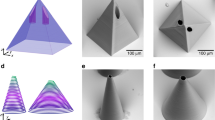Abstract
A two-wafer polysilicon micromolding process has been developed for the fabrication of hollow tubes useful for microfluidic applications. These small tubes can be fabricated with a pointed end, resulting in a micro hypodermic injection needle. Microneedles are desired because they reduce both insertion pain and tissue damage in the patient. Such microneedles may be used for low flow rate, continuous drug delivery, such as the continuous delivery of insulin to a diabetic patient. The needles would be integrated into a short term drug delivery device capable of delivering therapeutics intradermally for about 24 hours. In addition, microneedles can be used for sample collection for biological analysis, delivery of cell or cellular extract based vaccines, and sample handling providing interconnection between the microscopic and macroscopic world.
The strength of microneedles was examined analytically, experimentally and by finite element analysis. Metal coatings provide significant increases in the achievable bending moments before failure in the needles. For example, a 10 μ m platinum coating increased the median bending moment of a 160 μ m wide, 110 μ m high microneedle with a 20 μ m wall from 0.25 to 0.43 mNm. In addition, fluid flow in microneedles was studied experimentally. Microneedles 192 μ m wide, 110 μ m high and 7 mm long have flow rates of 0.7 ml/sec under a 138 kPa inlet pressure. This flow capacity exceeds previous microneedle capacities by an order of magnitude.
Similar content being viewed by others
References
N. Talbot and A.P. Pisano, Proceedings 1998 Solid State Sensor and Actuator Workshop Hilton Head, S.C., 25-268, (1998).
L. Lin, A.P. Pisano, and R.S. Muller, Solid State Sensors and Actuator Conference, Transducers '93, Japan, 237-240 (1993).
J. Chen and K.D. Wise, Solid State Sensor and Actuator Workshop, Hilton Head, S.C., 256-259 (1994).
K.S. Lebouitz and A.P. Pisano, Proceedings Microstructures and Microfabrication Systems IV, 194th meeting of the Electrochemical Society, Boston, MA, 1-6 (1998).
S. Henry, D.V. McAllister, M. Allen, and M. Prausnit, Proceedings of the IEEE Eleventh Annual International Workshop on MEMS, Heidelberg, Germany, 494-498 (1998).
D.V. McAllister, F. Cros, S.P. Davis, L.M. Matta, M.R. Prausnitz, and M.G. Allen, Transducers '99, 1098-1101 (1999).
D.V. McAllister, S. Kaushik, P.N. Patel, J.L. Mayberry, M.G. Allen, and M.R. Prausnitz, Proceedings of the First Joint BMES/EMBS Conference, Atlanta, GA, USA, 13–16 Oct. 1999; Piscataway, NJ, USA, IEEE, 1999 2, 836.
I.E. Papautsky, J.D. Brazzle, H. Swerdlow, and A.B. Frazier, IEEE International Conference on Engineering in Medicine and Biology Conference, (Chicago, IL, 1997).
J. Brazzle, I. Papautsky, and A.B. Frazier, IEEE Engineering in Medicine and Biology Magazine, 18(6), 53-58 (IEEE, 1999).
J. Brazzle, D. Bartholomeusz, R. Davies, J. Andrade, R.A. Van Wageman, and A.B. Frazier, Proceedings 2000 Solid State Sensor and Actuator Workshop Hilton Head, S.C., 199-202 (2000).
J.E. Lemons, F.J. Schoen, A.S. Hoffmann, and B.D. Rater (eds), Biomaterials Science: An Introduction to Materials in Medicine, (Academic Press, San Diego, CA., 1996), 165-173.
A. Bolz and M. Schaldach, Medical and Biological Engineering and Computing 31,Suppl:S123-S130 (1993).
M.Q. Zhang, T. Desai, and M. Ferrari, Biomaterials 19(10), 953-960 (1998).
C.G. Keller and R.T. Howe, International Solid State Sensors and Actuator Conference. Transducers '95, Stockholm, Sweden, 376-379 (1995).
P. Krulevitch, G.C. Johnson, and R.T. Howe, Mat. Res. Soc. Symp. Proc. 276, 79-84 (1992).
Author information
Authors and Affiliations
Rights and permissions
About this article
Cite this article
Zahn, J.D., Talbot, N.H., Liepmann, D. et al. Microfabricated Polysilicon Microneedles for Minimally Invasive Biomedical Devices. Biomedical Microdevices 2, 295–303 (2000). https://doi.org/10.1023/A:1009907306184
Issue Date:
DOI: https://doi.org/10.1023/A:1009907306184




